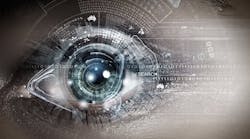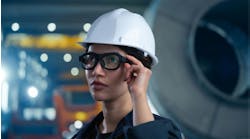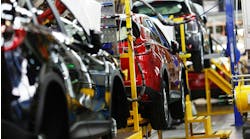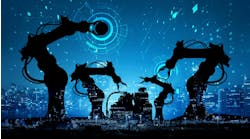Giving weary human eyes a rest & improving accuracy
Visual inspection of products coming off production lines has been commonplace since products began coming off production lines. And if a process involved human beings, it is going to involve human error.
Landing AI's Dongyan Wang
One solution: AI-powered vision detection, which gives manufacturers the ability to eliminate human error affected by lighting, angle, fatigue, distraction, etc. AI can quicken the inspection process and strengthen the quality of production.
To learn more we connected with Dongyan Wang, vice president of AI transformation at Landing AI. Take a look…
Smart Industry: What are the main causes of human error during the visual-inspection process?
Dongyan: Visual inspection is a repetitive task that’s visually and cognitively taxing. For a typical visual-inspection task on a manufacturing floor, a human inspector often views hundreds or even thousands of products streaming along a high-speed production line to spot small defects like scratches or cracks. This type of repetitive workload quickly leads to degradation in judgement; human errors ensue. When there is a rigid quality standard in place, it is hard for humans to consistently and objectively align with that standard. As a result, one inspector can look at the same exact product at two different times and provide a different verdict.
Also, manual inspection often produces inconsistent results due to lack of clear quality standards, especially for many variations of the same defect, and the level of training or experience of the inspectors. A study by Sandia National Laboratories found that human inspectors miss 20-30% of defects across multiple types of inspection tasks.
Smart Industry: Why does this process yield large amounts of false negatives?Dongyan: Manual inspection yields false negatives (escapes) for the reasons mentioned above. These mistakes can have serious implications for manufacturers because they may lead to returned products and damaged reputations.
Given the limitations of manual inspection, many manufacturers have turned to traditional machine vision, but this solution is far from perfect. While machine vision works well on objects with minimal variations, it struggles in situations that have variability or high complexity because traditional machine-vision solutions such as Automated Optical Inspection (AOI) are based on hard-coded rules or a golden image, which is comparing product images with a standard image without defect. As a result, it is not uncommon to see a rule-based system periodically classify a good part as defective (false positive or overkill) or vice versa, when there is any acceptable variation on the product. The rate could be as high as 40% for manufacturers, which requires manual reinspection.
Smart Industry: What opportunities does AI-powered vision detection have for manufacturers?
Dongyan: AI-powered vision detection presents two kinds of opportunities for manufacturers.
First, manufacturers can utilize AI-powered vision solutions to automate manual inspection. Recent breakthroughs in AI have greatly enhanced computer vision’s capabilities, enabling machines to perform tasks that were previously not feasible. For example, manufacturers today can use AI to automatically detect surface defects with confusing backgrounds or changing environments like lighting, scale and perspective.
Secondly, manufacturers can leverage AI to enhance their existing automated solutions. Most AOI solutions in the market today are rule-based machine vision. These solutions are often not very effective in situations that have variability or high complexity. AI can be more forgiving of the challenges faced by traditional vision and can be trained to tolerate variability and deviation. In general, traditional machine vision is good at gauging and precision, while AI excels at cosmetic inspections, classification of defects, assembly verification, part location and optical-character recognition.
We have demonstrated that AI-powered vision performs much better than the traditional rule-based machine vision in lowering false positives by as much as 95%.
Overall, AI-powered vision detection provides speed, accuracy and repeatability at a lower cost. In the long run, the data collected over time can provide valuable and actionable insights that can help manufacturers further optimize their operations.
Smart Industry: What is preventing AI-powered vision detection from taking off in manufacturing?
Dongyan: Building AI visual-inspection models has proven challenging and has held back many projects. The top challenges are:
- Small data. Whereas consumer internet companies may have big data from 1B or more users to train an AI system, a manufacturing plant may have only 10 or 100 or even fewer pictures of a particular defect they wish to detect. AI models developed for big-data problems do not work in small-data settings.
- Ambiguous-defect requirements. It is not uncommon for two inspectors to disagree with each other. Say, inspector #1 thinks a scratch is clearly a major defect, whereas inspector #2 thinks the same scratch is clearly small enough to be ignored. These inconsistencies lead to mislabeled data which, compounded with the fact that there is often only a small amount of data to work with, can have a huge impact on the model's ability to accurately make predictions.
- Changing environments and requirements.If a new defect starts cropping up in a manufacturing process, we need tools to quickly detect the change and update and validate the AI system. If, even in the absence of any manufacturing changes, QA decides to change the definition of what is or isn’t acceptable, we also need tools to enable such changes to be made quickly.
- Compounding complexities. If a large manufacturing company wants to deploy inspection to 100 products in 100 factories with 100 defects per product, how do we systematically keep track of the (100*100*100=1,000,000) resulting custom AI datasets and custom software components? This level of complexity, which multiplies or compounds as the number of deployments grows, is far greater than what any person can keep track of.
Smart Industry: How should business owners introduce this to their workforce, which might view this advancement as a threat to their jobs?
Dongyan: AI automates tasks, not jobs. Many of the visual-inspection tasks are labor-intensive, or even harmful to inspectors’ eyes. AI can help reduce the workload, enabling human workers to do higher value-add tasks. Moreover, manual inspection is usually one of the many duties that workers perform on production lines, and usually workers performing these tasks are absorbed within the factory to perform other tasks or redeployed on new assembly lines. We recommend business owners conduct thorough communications with their employees about the benefits and impact before introducing this to their workforce.





